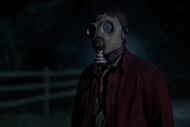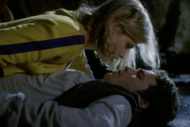Create a free profile to get unlimited access to exclusive videos, sweepstakes, and more!
Dark Josie, Dark Willow, and the queer witch in crisis

On Legacies, Josie Saltzman has spent her entire life waiting for her more powerful twin sister, Lizzie, to absorb her when they turn 22.
As twins and witches of the Gemini Coven — a whole thing for another day — Josie and Lizzie are required by coven tradition to partake in the Merge with the triumphant sibling becoming the leader of the coven.
OK, listen, I know the entire premise is f***ed, but then again, this is a series about the children of characters from both The Vampire Diaries and The Originals — it has to carry all the established lore from those series. And, to be quite honest, Legacies is better than either of its predecessors, so we'll give it a pass for the whole stronger-twin-absorbs-the-weaker-one premise. And Jo's story complicates that narrative and others about queer witches in productive and interesting ways.
Other than the Merge which looms over the Saltzman twins, Legacies portrays a boarding school for witches, vampires, werewolves, hybrids, and one very special tribrid. Like any great series about teenagers with powers, it explores love, friendship, and of course, the use and abuse of power — both supernatural and more common.
In Season 2, which ended unexpectedly due to the pandemic earlier this year, Josie is tricked into using what the show refers to as dark magic. By the time she realizes the person helping her grow her powers is not who he seems, it's too late. The dark magicks are already bubbling inside her. So, as you do, Josie decides to repress her experiences with dark magic — just like she's repressing her heartbreak over her break-up with her boyfriend and her general bad luck with relationships with both men and women. Teenagers.
But when her kinda dead uncle traps Lizzie, their father Alaric, and Josie in a prison dimension offering her only the use of dark magic to escape, Jo can't avoid using the magics to open a portal back to their home dimension. Though she seems to have the dark powers on lock after leaving the prison world, as the season reaches its climax, it becomes clear she's failed — and the magic takes over.
While there are plenty of awesome representations of queer witches such as Ambrose in Chilling Adventures of Sabrina and Raelle in Motherland that we could talk about in conversation with Jo, there's really only one comparison that can't help but be drawn: Dark Josie conjures Dark Willow.
In Buffy the Vampire Slayer, after Willow's girlfriend Tara is murdered, Willow decides she's done dabbling in dark magic and goes full Dark Phoenix, to quote one of the people she hunts down. Her hair changes from Alyson Hannigan's characteristic red fury to black and she gets these cool black veins all over her face.
As Dark Willow, she flays the man who murdered Tara and then is like, "You know what? F*** it. I'm gonna end the world." It is only when Xander finds her and tells her that he loves her that she reverts to heartbroken, redheaded Willow. It's kind of a nice moment if you can ignore the fact that a weak ass dude had to come help control the scary powerful she-witch, which obviously, I cannot.
At first, when Dark Josie appears, she follows the Dark Willow playbook. She tries to force Lizzie to merge with her, knowing that she's powerful AF and will absorb her. She siphons power off of her friends and tries to kill her kinda-sister, the aforementioned tribrid Hope.
But, Hope knew this was all coming and implants herself into Josie's subconscious where she's determined to find their Jo and help her regain control of her body from Dark Josie.
As Hope enters Josie's fairy tale-esque mind, she encounters an adorable little pig person who then tries to help her avoid Dark Josie. Of course, Hope, who is often called Super Woman by her peers, just wants to throw down with Dark Josie, but it turns out that Dark Josie is all-powerful in… her own mind, which duh.
The similarities are obvious. Both the Dark Willow and Dark Josie storylines are about power and the corruptibility of extreme power even in the best of hands. Willow and Josie are also similar characters: queer, quiet, bookish, but fierce AF underneath it all. But where Willow becomes a symbol of the way power, pain, and grief will corrupt anyone, Josie offers a different interpretation.
It is revealed that Josie was the little cutie pie pig person the whole time and as she confronts her alter ego Dark Josie inside her own mind, she comes to an important realization. Josie realizes that the darkness is not from without, but from within — that she is the one who makes her power evil, acknowledging that the power itself is neutral. Thus, the key to stopping her dark reign is deciding that she doesn't want to be that person any longer.
Josie says, "I was afraid of being strong. I thought being strong meant hurting Lizzie. I told myself that being powerful meant being evil, but it doesn't. Hope is strong, and she's good. I made a story where I was powerless. But that's not true." And with that, Josie seizes her power and becomes neither the Josie she was before nor Dark Josie. She is someone new — someone we've yet to meet.
Some people have gotten up in arms about the similarities between Dark Willow and Dark Josie, but as similar as they are, the differences matter more. Dark Willow is ultimately at the whim of her power and in Season 7 of Buffy when she learns to control her magics, they're suddenly no longer dark and her hair turns an angelic white instead of a sinister black! Whatever work Willow does to understand her powers takes place mostly offscreen (to be fair, it is a series about the Slayers, so I get it).
But, with Josie, her development happens onscreen. Instead of being saved by a dude, she saves herself by realizing she has more control than she thought. Josie advances the narrative of the queer witch in crisis and in so doing, she offers a new example to young, powerful queer women: You can be a badass without losing yourself — you get to choose how to use your power.





























